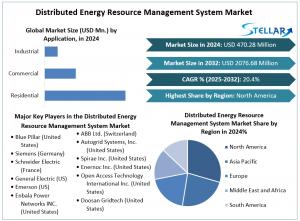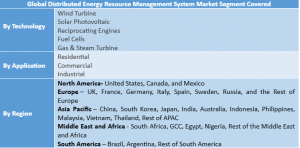Distributed Energy Resource Management System (DERMS) Market – Global Industry Analysis and Forecast (2025–2032).
Distributed Energy Resource Management System Market is estimated to grow at a CAGR of 20.4% over the forecast period.
They facilitate an entirely new model for operations on the grid, allowing customer-sited resources to deliver real value to the grid faster, more flexibly, and more cost-effectively than ever before.”
ORLANDO, FL, UNITED STATES, November 18, 2025 /EINPresswire.com/ -- Market Overview:— Navneet Kaur
The Distributed Energy Resource Management System (DERMS) Market is growing rapidly as utilities and organizations embrace a shift towards the grid and are increasingly integrating distributed energy resources (DERs), including solar PV, wind resources, EV chargers, and battery storage. DER connectivity within a DERMS solution provides real-time visibility, forecasting, and optimization for those assets; thereby contributing to grid stability and reducing operational costs. Increased electricity consumption, decarbonization initiatives, and grid modernization projects across major economies are contributing to the overall growth of this energy sector. Additionally, advanced analytical capabilities, AI-powered forecasting information, and the increased deployment of residential solar serve as global catalysts for the DERMS market.
Market Dynamics:
Drivers:
Policy and renewable drivers: All over the globe, governments are advancing renewable capacity, establishing decarbonization goals, and accelerating clean-energy deployment that supports DERMS uptake.
Growing DER trends: Corporations are making greater commitments to green energy and increasing their distributed renewable portfolios, along with their number of renewable PPAs, to create demand for better DER management.
Energy storage solutions: New battery storage projects will provide greater reliability to the grid as well as a greater ability to optimize the renewable energy mix through DERMS capabilities.
Smart grid automation: Utilities are increasingly leveraging AI to develop solutions for monitoring the grid, to automate operations and outages, and to improve the efficiency and reliability of the grid.
👉 Access the full Research Description at: https://www.stellarmr.com/report/req_sample/Distributed-Energy-Resource-Management-System-Market/303
Restraint:
High capital investment and maintenance costs: Utilities and organizations of any kind must make significant investments in smart grid infrastructure, engage in internal coordination across teams for ownership, and maintain operations for the long term, leading to slow deployment of DERMS in some regions.
Segment Overview:
By Application – Residential Segment:
In 2024, the Residential segment was the largest segment within the Distributed Energy Resource Management System (DERMS) market, representing 48.3% value share of the overall market. The primary focus of residential DERMS solutions is instilling energy efficiency across several end-uses within a fixed residential structure. This includes electricity consumption in heating, cooling, lighting, water heating, and consumer appliances. Homeowners are opting for solar photovoltaic (PV) systems, battery storage, and smart energy management technologies, all at their cost, to drive down electricity bills and boost their homes’ energy efficiency. In spite of the high capital and installation costs, the escalating focus on sustainability, rapid adoption of renewable energy and liberalization, and government incentives to foster energy efficiency upgrades in the residential sector are all aiding the segment's acceleration. Distributed energy systems are also contributing towards grid stability on a residential basis by contributing to the management of energy supply during peak load periods and also supplying backup energy during outages.
👉 Access the full Research Description at: https://www.stellarmr.com/report/req_sample/Distributed-Energy-Resource-Management-System-Market/303
Regional Overview:
In 2024, North America captured the highest share of the DERMS market with 43% of the global share. Growth in the region was driven by a higher demand for electricity, coupled with stricter federal policies surrounding carbon reduction and modernization of the power grid to accommodate distributed energy resources. Additionally, utilities and energy providers are increasingly implementing DERMS solutions to accommodate renewable energy integration, increase grid performance, and address environmental regulations.
Conversely, the Asia Pacific region is anticipated to exhibit exceptional growth within the forecasted period at a CAGR of 19.3%. The rapid urbanization, population growth, demand for energy, and growing discretionary incomes in countries such as China, India, Indonesia, and Malaysia contribute to driving adoption. Government programs in the region also provide incentives for renewable energy, therefore increasing demand for distributed energy resource management solutions.
Recent Development
April 10, 2025 - The PJM grid operator announced a multiyear partnership with Google and Tapestry to implement AI-driven tools for fast-tracking new generation (DER) applications and integration to the grid.
October 7, 2025 — Maharashtra State Electricity Distribution Co., Ltd (MSEDCL) signed a Statement of Intent with the Global Energy Alliance for People and Planet (GEAPP) to enhance its power grid using AI/ML and battery storage (BESS) as well as ancillary technologies and analytics to enhance distributed renewable energy integration.
February 11, 2025 — MSEDCL announced its goal to provide 100% green energy (solar) for agricultural pumping by March 2026 as part of its clean energy transition and DER integration plan.
FAQs
What is a Distributed Energy Resource Management System?
A DERMS is a software platform that supports utility and grid operators in the monitoring, control, & optimization of distributed energy resources (DERs), like solar panels, wind turbines, battery storage, and controllable loads. Ultimately, it improves grid reliability, improves the integration of renewable resources, and supports real-time decision-making to complement what is happening on the grid.
Why is DERMS adoption increasing around the world?
This is an outcome of the drive from rapid renewable energy development, government mandates for decarbonization, increasing electricity demand, and the challenges of advanced grid automation that is needed to effectively monitor and control distributed energy resources.
Which industries or sectors are driving DERMS development?
The residential, industrial, and commercial sectors are all ready, willing, and able to invest in this new technology and have been the most prominent adopters of DERMS. Residential markets are adopting DERMS with the addition of rooftop solar, battery systems, while industrial, commercial, and emerging micro-sourcing users are using DERMS for energy efficiency, cost savings, and resilience.
How does a DERMS support renewable energy resource integration?
DERMS platforms provide real-time monitoring and control of DERs, offer optimized usage of energy storage, and facilitate the coordination of distributed resources with grid operations. The adoption of DERMS makes it feasible to have an increased penetration of renewable energy without compromising overall grid stability and protection of upper-level distribution system reliability.
What are the primary challenges to DERMS development?
Challenges include high initial capital and deployment costs, complex coordination with existing grid infrastructure, operational and maintenance challenges, and determining the network security of each of the connected nodes in the system.
Related Reports:
Instrument Transformer Market: https://www.stellarmr.com/report/instrument-transformer-market/2839
Power Distribution Unit Market: https://www.stellarmr.com/report/power-distribution-unit-market/2823
Carbon Capture, Utilization and Storage Market: https://www.stellarmr.com/report/carbon-capture-utilization-storage-market/2817
Casing Cementation Hardware Market: https://www.stellarmr.com/report/Casing-Cementation-Hardware-Market/2794
Offshore Support Vessel Market: https://www.stellarmr.com/report/Offshore-Support-Vessel-Market/2791
About Stellar Market Research (SMR)
Stellar Market Research (SMR) delivers data-driven insights across 12,000+ industries, providing accurate market forecasts, competitive analysis, technology trend evaluation, and strategic recommendations. SMR enables businesses, investors, and policymakers to make informed decisions backed by reliable and objective research.
https://www.stellarmr.com/report/Distributed-Energy-Resource-Management-System-Market/303
Lumawant Godage
Stellar Market Research
+ +91 9607365656
email us here
Visit us on social media:
LinkedIn
Instagram
X
Legal Disclaimer:
EIN Presswire provides this news content "as is" without warranty of any kind. We do not accept any responsibility or liability for the accuracy, content, images, videos, licenses, completeness, legality, or reliability of the information contained in this article. If you have any complaints or copyright issues related to this article, kindly contact the author above.


